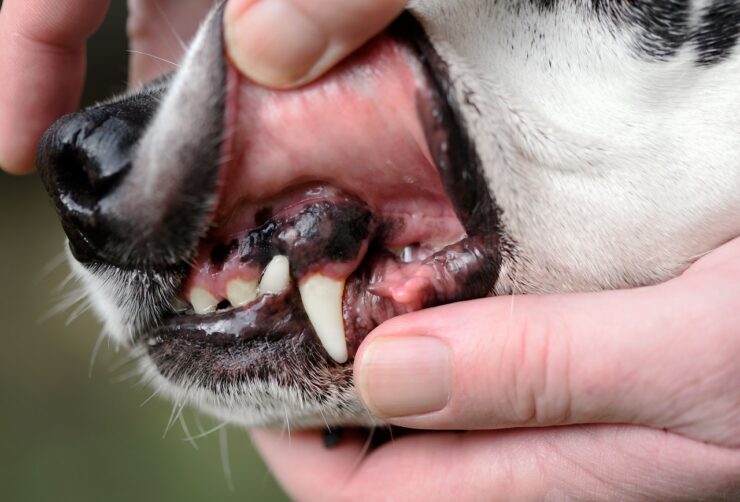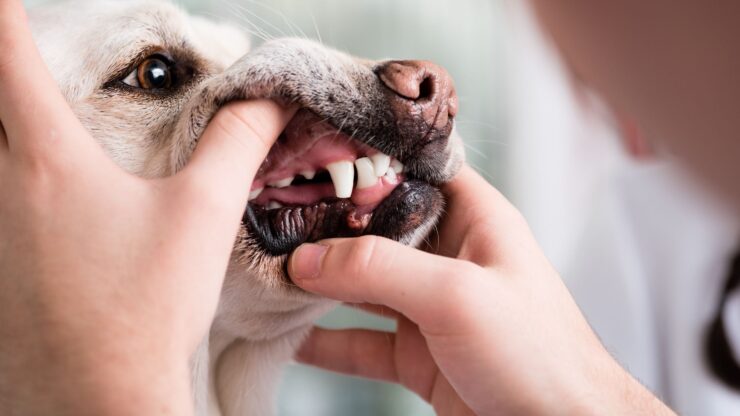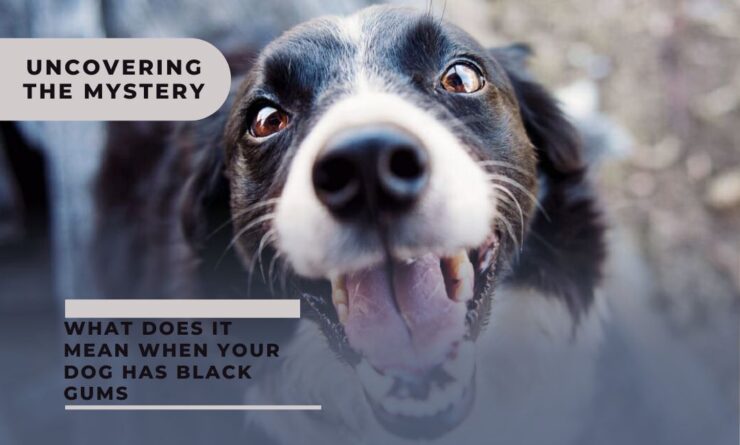If your dog’s gums have turned black, you might be concerned about this change.
It’s crucial to determine whether your dog has always had black gums or if this is a sudden change.
Many dogs have black pigmentation in their mouths, which is simply a normal trait they are born with.
However, when a dog’s gums turn black, there could be various causes for this.
Typically, a dog’s gums are pink, except for certain breeds like the chow chow or Chinese shar-pei, known for their bluish/black tongues and black or mottled gums.
If you’ve noticed your dog’s gums turning black, read on to learn about potential explanations. However, consult your vet immediately if your dog seems unwell, has trouble breathing, or if the black gum area appears raised.
Normal Pigmentation in a Dog’s Gums

As mentioned earlier, some dogs naturally have black areas in their mouths, and in most cases, it’s simply normal pigmentation.
Black gums can be a genetic trait in some dog breeds.
Dog owners who notice their dog’s black gums might not have carefully examined their dog’s mouth before or haven’t checked the gums in a while.
The last time they looked, their dog might have been a puppy, and now the dog has matured, resulting in black gums due to melanin.
If your dog is healthy and happy, you are likely dealing with normal pigmentation that you haven’t noticed before.
Many dogs have black in their mouths, but most have a pink tongue (or partially spotted) unless they are a Chinese shar-pei or chow chow.
Lentigo Presence
Lentigo is an asymptomatic condition where a dog develops flat, pigmented spots on their skin or inside their mouth.
Lentigines refer to multiple individual pigmented patches that resemble freckles.
Lentigo is common in middle-aged to older dogs.
These pigmented areas are only of cosmetic importance, similar to freckles on human skin.
“Normal pigmentation that some dogs develop as they age…It is very normal in some dogs, like us getting age spots or grey hair. As long as they’re not raised at all, you’re fine, but if you notice any raised area, it’s time to have a veterinarian examine her.” ~Dr. Altman, veterinarian
Age-Related Changes
In older dogs, the color change in gums might be due to aging.
As dogs get older, color changes can occur, and gums might change from pink to black, as can their tongues, explains veterinarian Dr. Beth.
Hyperpigmentation is the medical term for patches of skin that become darker than the surrounding skin.
When to Worry About a Dog’s Dark Gums?

It’s more concerning when a dog’s previously non-black gums turn black or when the dog appears unwell.
If your dog’s gums were pink a day or two ago and now appear suddenly black, or your dog appears sick, it can be concerning.
Please consult your vet if you have any concerns.
Inflammation-Related Changes
Occasionally, pigmented areas on a dog’s gums result from inflammation.
The color change in a dog’s gums may be secondary to inflammation, as can happen when losing a tooth.
In such cases, inflammatory cells (macrophages) release melanin during inflammation, causing the black color.
This gum discoloration typically won’t disappear, as it’s the end result of the inflammation, notes veterinarian Dr. Peter.
Addressing the underlying inflammation is essential.
Cancer Indicator
Any new, raised area with a color change compared to the rest of the gums warrants a vet’s examination.
The primary concern here is cancer, particularly melanoma, which is not uncommon in a dog’s mouth.
In this case, we’re referring to a raised, black lesion rather than a simple pigment change affecting the dog’s gums.
Unfortunately, oral melanoma is the most common malignant tumor found in dogs’ mouths.
The lesion typically localizes in one spot rather than spreading throughout the dog’s mouth, as can occur with lentigo, explains veterinarian Dr. Salkin.
In addition to a black, raised lesion, affected dogs often exhibit bad breath, chewing problems, mouth bleeding, or a pigmented mass.
While black pigmentation is common in melanoma cases, sometimes the mass may appear fleshy-colored and non-pigmented, states Dr. Gerald Post, a board-certified veterinarian specializing in internal medicine, in an article for DVM360.
If you notice a new pigmented area in your dog’s mouth, consult your veterinarian.
“If you feel there are any raised black areas or black growths, you should have this assessed by your vet. Melanoma is a possibility if this is the case.” ~Dr. Peter, veterinarian
Insufficient Oxygenation Due to Heart/Lung Disease
A dog’s gum color can indicate the dog’s circulation.
Cyanosis is the medical term for bluish-black skin discoloration due to poor circulation or inadequate oxygenation of the blood.
Healthy, oxygenated gums are a bright bubble gum pink.
Gums turning bluish/black can indicate insufficient oxygenation.
In this case, the color change happens suddenly and is often accompanied by other concerning signs like the dog experiencing difficulty breathing.
If you notice any trouble breathing along with black gums, take your dog to the vet immediately.
Your dog may have heart or lung disease (cardiopulmonary disease) or a red blood cell disorder, explains veterinarian Dr. Peter, so consult your veterinarian right away.
Inadequate Circulation Due to Red Blood Cell Disorders
Occasionally, the blue/black gums could be caused by the destruction of the dog’s red blood cells. This occurs when the hemoglobin in the dog’s red blood cells lacks adequate oxygen or is unable to carry oxygen altogether.
This can happen as a result of the dog’s immune system, as with immune-mediated hemolytic anemia (IMHA), other red blood cell disorders, or due to shock.
Dog can developed black gums almost overnight and was suffering from poor oxygenation due to a red blood cell disorder caused by a rare type of cancer, hemophagocytic histiocytic sarcoma (HHS).
Dogs with this condition often develop severe red blood cell disorders. This cancer may be accompanied by thrombocytopenia and moderate to marked, regenerative, hemolytic anemia.
Notice the dark gums, pale gums, and pale tongue as well.
An Indicator of Gum Disease

If the gums around a dog’s teeth are black rather than the entire gums, it could be a sign of gum disease.
If your dog’s gums are bleeding, receding, and there is a foul, unpleasant odor coming from the dog’s mouth, it is possible that the darkness around the teeth is caused by gingivitis or a bacterial infection occurring along the gum border, explains veterinarian Dr. Bruce.
In such cases, it’s a good idea to have the vet check the area and determine what’s happening.
Your dog might need a dental cleaning to remove any tartar.
What to Do If Your Dog Has Black Gums
It’s crucial to identify whether the color change is limited to a specific area or affects the entire gums.
If it’s localized to a certain area, it’s essential to determine if the area is smooth or bumpy.
Generally, smooth surfaces suggest something benign, but it’s always best to consult the vet when in doubt.
If there seems to be a bump or mass in the area, this could indicate a tumor or cancer and requires immediate investigation.
If your dog suddenly develops black gums and has a heart murmur or other heart condition and/or displays signs of difficulty breathing, it’s crucial to visit the emergency vet right away.
Hence, it’s important to inform the vet about the change just to be cautious.
Any changes in a senior dog should not be dismissed as insignificant.
FAQ
1. What are the possible reasons for my dog’s gums turning black?
There are several potential explanations for a dog’s gums turning black, including normal pigmentation, lentigo, age-related changes, inflammation, cancer, insufficient oxygenation due to heart or lung disease, or inadequate circulation caused by red blood cell disorders. It’s essential to consult your veterinarian if you’re concerned about your dog’s gum color.
2. How can I tell if my dog’s black gums are normal or a cause for concern?
Normal pigmentation in a dog’s gums may be a genetic trait and not a cause for concern. However, if your dog’s gums were previously pink and suddenly turned black, or if there are raised black areas or growths, it’s crucial to consult a veterinarian. Additionally, if your dog appears unwell or has difficulty breathing, seek veterinary assistance immediately.
3. Can black gums be a sign of gum disease in dogs?
Yes, black gums around a dog’s teeth could be an indicator of gum disease, such as gingivitis or bacterial infection along the gum border. Symptoms may include bleeding, receding gums, and a foul odor coming from your dog’s mouth. In such cases, a veterinary examination and dental cleaning may be necessary.
4. Are there specific dog breeds more prone to having black gums?
Certain dog breeds, like the chow chow and Chinese shar-pei, are known for their bluish/black tongues and black or mottled gums. It’s essential to be familiar with your dog’s breed characteristics to understand whether their black gums are a normal genetic trait or a potential health concern.
5. How can I maintain my dog’s gum health and prevent gum diseases?
Regular dental care is crucial for maintaining your dog’s gum health. This includes daily teeth brushing using a dog-specific toothpaste, providing dental chews and toys, and scheduling professional dental cleanings with your veterinarian as needed. Regular dental check-ups with your vet can help identify any potential issues early on and prevent the progression of gum diseases.
6. How do I know if my dog’s gums are healthy?
Healthy dog gums are typically a light pink color, similar to shrimp, and should be moist with minimal plaque or tartar buildup. There should be no strong odor, swelling, or significant lesions and pus. If you’re unsure about your dog’s gum health or notice any changes, consult your veterinarian for a thorough examination.
Conclusion
In conclusion, maintaining your dog’s gum health is crucial for their overall well-being. It’s essential to monitor any changes in your dog’s gums and be familiar with what is normal for their breed. While some dogs naturally have black gums due to genetics, there are various reasons for a dog’s gums to turn black, ranging from benign age-related changes to more serious health concerns.
Regular dental care and check-ups with your veterinarian can help prevent gum diseases and ensure your dog’s gums remain healthy. If you notice any changes in your dog’s gum color, raised areas, or if your dog appears unwell, it’s vital to consult your veterinarian promptly for a thorough examination and appropriate treatment.













